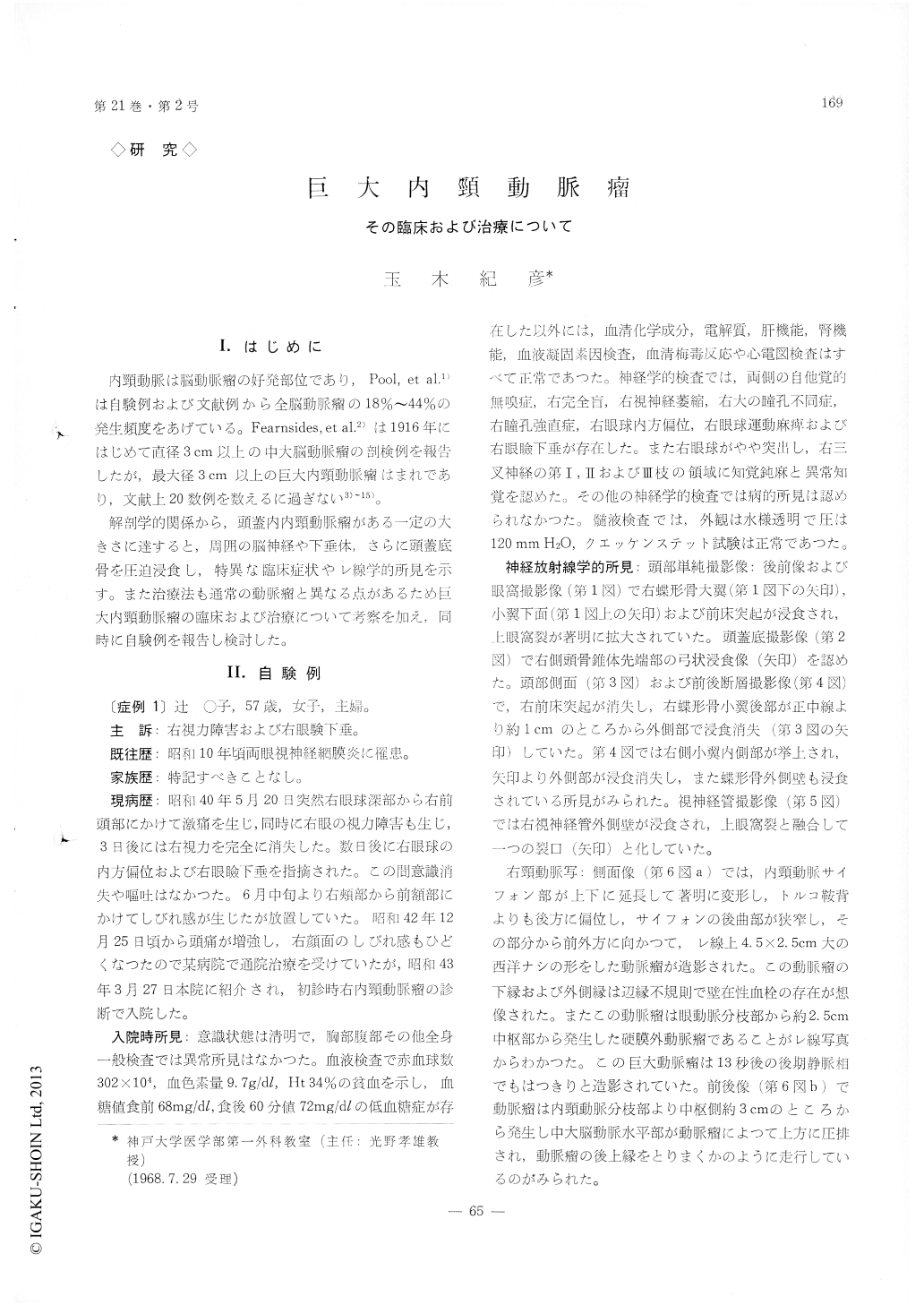Japanese
English
- 有料閲覧
- Abstract 文献概要
- 1ページ目 Look Inside
I.はじめに
内頸動脈は脳動脈瘤の好発部位であり,Pool, et al.1)は自験例および文献例から全脳動脈瘤の18%〜44%の発生頻度をあげている。Fearnsides, et al.2)は1916年にはじめて直径3cm以上の中大脳動脈瘤の剖検例を報告したが,最大径3cm以上の巨大内頸動脈瘤はまれであり,文献上20数例を数えるに過ぎない3)〜15)。
解剖学的関係から,頭蓋内内頸動脈瘤がある一定の大きさに達すると,周囲の脳神経や下垂体,さらに頭蓋底骨を圧迫浸食し,特異な臨床症状やレ線学的所見を示す。また治療法も通常の動脈瘤と異なる点があるため巨大内頸動脈瘤の臨床および治療について考察を加え,同時に自験例を報告し検討した。
1) Two cases of the giant aneurysm, one arising from the infraclinoid portion of the internal carotid artery measuring 4. 6/4. 6 cm in a 57-year-old female, the other involving the supraclinoid portion mea-suring 3. 0/1. 5 cm in a 49-year-old female, were reported.
2) The incidence, symptomatology, diagnosis, therapy and prognosis of the giant aneurysm of the internal carotid artery together with giant aneurysm of the other cerebral arteries (in general) were discussed, reviewing the associated literatures in the world.
3) The giant aneurysm of the internal carotid produces typical symptoms ; cavernous sinus syn-drome, which consist of ophthalmoplegia and invol-vement of the motoric eye nerve as a manifestation of the internal carotid aneurysm was also briefly mentioned. The clinical picture of our two cases comprised ophthalmoplegia, lesion of the trigeminal nerve, optic nerve and facial nerve in one case.
4) Intracranial diseases involving the cavernous sinus, bony structures arround the superior orbital fissure and the sella turcica, such as pituitary tumor, parassellar menigioma and craniopharyngioma, and malignant nasopharyngeal tumors must be ruled out in the differential diagnosis.
5) A brief review on the mechanism of growth and rupture of the cerebral aneurysm was also made of the pertinent literatures. It can be said that the larger, multiloculated aneurysm is more likely to rupture than the smaller uniloculated one. There-for the larger aneurysm is more dangerous.
6) The giant aneurysm of the internal carotid, especially one involving the intracavernous portion, usually reveals important neuroradiological signs. Important radiological changes in the plain X-ray of skull are ; 1. Erosion of the great wing of thesphenoid and widening of the superior orbital fis-sure, 2. Erosion of the infero-lateral margin of the optic foramen, 3. Erosion of the bony structures surrounding the sella turcica, 4. Curvilinear calci-fication in the wall of the aneurysm. Arteriography in the diagnosis of the cerebral aneurysm is utmost important.
7) As for treatment of the giant aneurysm of the internal carotid especially infraclinoid one, the ligation of the carotid artery in the neck is indicated. Before obstructing the carotid artery, one must confirm that there is no evidence of cerebral circu-latory insufficiency clue to carotid occlusion through Matas test or cross compression angiography.
Common carotid occlusion is more safer than in-ternal carotid occlusion.
Gradual occlusion by using controllable clamps is safer and is the procedure of choice in the treat-ment of the giant internal carotid aneurysm.

Copyright © 1969, Igaku-Shoin Ltd. All rights reserved.


